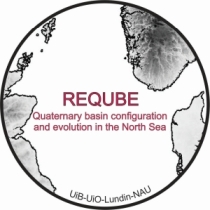About the project
Major discoveries in the North Sea in 2011 show the importance of new geoscientific knowledge and methods for mature exploration areas.
In mature petroleum provinces like the North Sea Basin (NSB), new quantitative data are required in order to increase reserves, extend the life of existing fields, and reinvigorate exploration interest.
In order to achieve this a significant knowledge gap relating to the Quaternary NSB configuration and evolution has to be tackled. REQUBE focuses on the thick (locally >1000 m) Quaternary overburden because it has significant implication for further exploration and recovery of deeper hydrocarbon systems but is relatively underexplored in comparison.
Objectives
The primary objective of REQUBE is to date and interpret the genetic origin of the overburden within the North Sea Basin and the implications this has had for basin evolution in terms of recent generation of hydrocarbons (maturation/migration), regional and local tilting of traps (fill-spill, re-migration), seal integrity and reservoir quality.
This will be achieved through the following secondary objectives:
- Determine the genetic origin of sediments by combining lithological, chronological and geophysical data.
- Provide a detailed chronology using strontium and amino acid analyses.
- Use seismic data to produce a high-resolution seismostratigraphy of glacial/interglacial sedimentary sequences within the overburden tied to the dated sedimentary archived from boreholes.
- Apply backstripping along regional seismic profiles to provide quantitative results for basin subsidence.
- Integrate and synthesize results through petroleum system modelling.
Outcomes
REQUBE will promote knowledge creation and will require multidisciplinary cooperation and cross-disciplinary integration involving both academia and industry while tackling an important research priority area, namely acquiring new knowledge related to geology and the subsea areas.
REQUBE strives to not only solve a long-standing controversy regarding the number and length of time continental-scale ice sheets have advanced into the North Sea Basin but also the implication this had on the rate of basin subsidence. These data will not only be an important resource for the petroleum industry but also the paleoclimate community for validation of climates, ice sheet, and ocean models. Access to previously acquired seismic data using recently developed acquisition techniques (BroadSeis, GeoStreamer, P-Cable) from Lundin will be applied to paleoenvironmental studies and greatly enhance the expertise of the research group in this key area that is not only relevant to the North Sea Basin but to the source to sink basin analysis in general.
Background
During Cenozoic times the margins of the North Sea Basin were exhumed whereas the centre of the basin underwent subsidence and infilling. The tilting and subsidence history of the basin, particularly during the late Cenozoic is only poorly constrained at a regional level and the magnitude, mechanisms, and timing of these processes still need to be defined. This is due to a large extent because of the complex glacial interglacial conditions that became amplified during the Quaternary and led to the advance and retreat of continental-scale ice sheets in the Northern Hemisphere accompanied by significant increase in sedimentation rates and global sea level variability.
Since the mid-Cenozoic up to 3000 metres of Oligocene to Holocene sediment has accumulated in the Central Graben region. The regional tilting is mainly the cumulative effect of uplift/erosion/unloading in the sediment source area and the deposition/loading/subsidence in the basin depocenters (the sink). To quantify this effect, a better understanding of the isostatic effects of these processes has to be established as well as the time involved. On a shorter temporal (time) and spatial (wavelength) scale information is needed on the effects of glacial loading and unloading through the glacial cycles affecting the area. Both effects may have affected the sealing potential of caprocks and reservoir quality in the area.
The consequential effects of repeated glacial overriding on the geomechanical stability of the underlying strata can only be obtained by detailed sedimentological information obtained from boreholes. Since exploration for petroleum began in the North Sea in the 1960’s, it became apparent that the northern and central graben of the NSB contained Quaternary sediments up to around 1000 metres thick. However, the availability of high-quality core or well material has been limited and has resulted in very little research on these sediments to develop accurate chronologies and understand their depositional environments and genesis. This is needed if basin subsidence and burial history is to be interpreted. Comprehensive sample collection and analysis of NSB Quaternary sediments along backstripped seismic profiles is proposed here. The NSB holds direct evidence of multiple glacial cycles. The ability to identify and refine the chronology of these sediments would allow a detailed depositional and chronological framework to be established and the impact of glaciations on the burial rate and loading and unloading of the basin to be investigated.
Financing
REQUBE is funded by the Research Council of Norway (RCN #190748) through the Large-scale Programme for Petroleum Research (PETROMAKS2). The total funding is approximately 11M NOK.
The project duration is 4 years, starting in January 2018.
Cooperation
The REQUBE project is a research collaboration between academia and industry. The project partners are;
- University of Oslo
- University of Bergen
- Northern Arizona University
- Lundin Norway AS
The Department of Earth Science, University of Bergen is the host institution for the research project.
